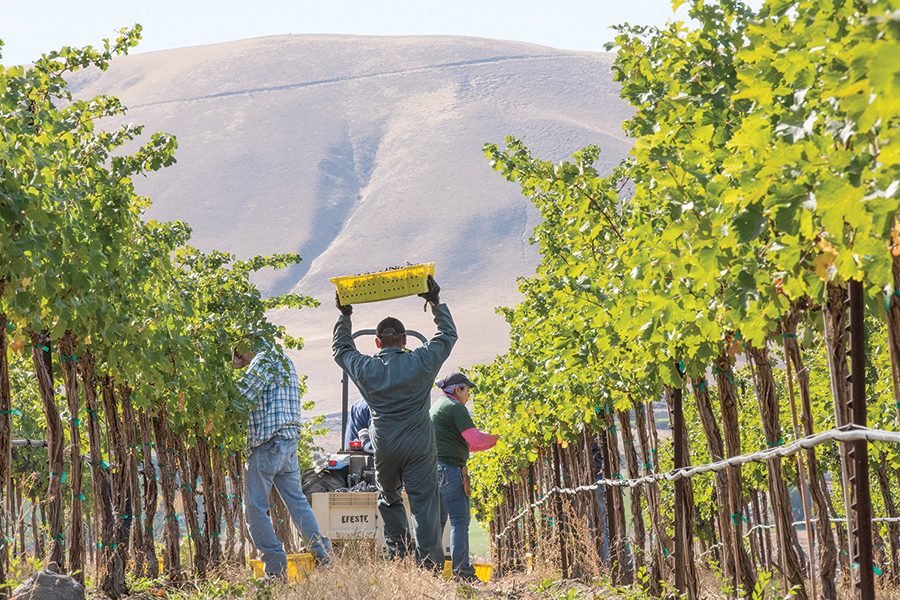
Home » 2020 wasn’t a great year for Washington wine. Or was it?
2020 wasn’t a great year for Washington wine. Or was it?

June 14, 2021
Northwest wine economist Chris Bitter painted a bleak picture when he recapped the state of Washington’s $8.4 billion wine industry in March.
The state’s wineries shipped almost 1 million fewer cases in 2020. All sales channels – to consumers, to retailers, to distributors – fell in 2020, according to Bitter, of Vancouver, B.C.-based Vintage Economics.
The Covid-19 pandemic bears some, though hardly all, of the blame. Washington winemakers were dealing with a national glut of both wine and grapes even before coronavirus reached U.S. shores.
“Going into the pandemic, the channel of distribution was full, even backed up,” said Vicky Scharlau, executive director of the Washington Winegrowers Association, which represents grape growers.
Washington is the second largest producer of premium wine in the U.S. With more than 1,000 wineries and 400 vineyards, the state produces nearly 18 million cases annually, according to the Washington Wine Commission.
Not so bad

Was 2020 as bad as it sounds? As the saying goes, “lies, damned lies, and statistics.”
Yes, overall shipments fell – sharply – in 2020, but the industry found success by pivoting to curbside sales, focusing on wine clubs and other innovations.
Four in 10 wineries increased shipments, according to Bitter. Royal Slope, near Quincy, became the state’s 15th federally recognized American Viticultural Area, or AVA. The Washington Liquor and Cannabis Board (WLCB) said 2020 wine tax collections were unchanged at $26.5 million.
Bitter called it a “respectable performance given the circumstances.”
He also noted an 8% increase in wine shipments in early 2021, news that Eric Degerman of Great Northwest Wine discusses in the Tri-Cities Area Journal of Business’s annual Focus: Agriculture + Viticulture magazine inserted in this month’s edition of the paper.
Bitter highlighted two growth stories as a counterweight to the gloom of 2020.
Seattle-based Precept Wine, the second largest brand in Washington with 30 labels, reported a 12% increase, according to Bitter’s research, which is based on WLCB data.
Aquilini Wines, a newcomer to the Red Mountain AVA outside Benton City, successfully launched several national brands – Dixie & Bass, Be Human, Roaming Dog and 10,000 Hours.
Steve Warner, president of the Washington Wine Commission, was euphoric about the successes eked out in 2020 and how the lessons learned will benefit the industry moving forward.
Successful wineries that had depended on retail and tasting room sales embraced curbside pickups and packaged meals and wine for date nights. The WLCB loosened regulations to allow for curbside delivery and restaurant pickups.
And Washington consumers responded to the commission’s Buy Local campaign efforts.
In one sense, the pandemic served as a pilot for nontraditional sales that Warner hopes will persist now that restaurants and tasting rooms have reopened.
“I was really proud,” he said.
Glut eases?
Washington vineyards and wineries have struggled with a glut since 2016, when the state’s largest – by far – winery halted growth and moved to “reset” its business as supply outpaced demand.
In 2016, Ste. Michelle Wine Estates, a division of Altria Corp., moved to limit production and curtail grape purchases, leading to the glut that persists today.
Ste. Michelle shipped 7.3 million cases in 2020, down 12%, according to its parent company’s fourth quarter and year-end report. Ste. Michelle wrote off $411 million in inventory losses and non-cancelable wine grape purchases. The parent company’s wine revenue fell 11% in 2020, to $614 million.
David Dearie was appointed chief executive officer for Ste. Michelle on Nov. 1, 2020. Warner, of the wine commission, said he’s optimistic Ste. Michelle has reset and remains committed to the state’s industry. Ste. Michelle brands account for more than half of all wine produced in Washington.
The company backed the wine commission’s work to establish a Washington-specific sustainability designation for wine, which will roll out later this year.
“They want to see Washington wine brands succeed nationally and internationally. They’re a very, very strong partner,” he said.
Its difficulties unquestionably spilled over to wine growers.
Typically, Washington wineries require about 220,000 tons per year, well below the state’s production capacity of more than 250,000 tons on 60,000 acres of vineyards.
In a bit of good news from a supply-and-demand perspective, 2020 production fell to 179,000 tons because of freezing weather, poor fruit set, damage caused by the wildfire smoke that blanketed the region for weeks and other economic factors.
Scharlau, of the winegrowers association, said a lower-than-normal harvest was not good news for individual growers, who typically have contracts to produce fruit for winemakers. Growers and winemakers are in constant contact about grape quality and quantity, adjusting as the season progresses to the fall harvest.
Scharlau said the association encouraged growers to use the pandemic and slowdown in sales to review their grape portfolios. If a variety is struggling or is losing popularity with consumers, it’s time to switch courses.
“Get rid of and replace some of the weak players,” she said.
Warner, of the wine commission, said the imbalance is easing after two years of lower-than-expected grape harvests.
“What I’m hearing from growers is they have buyers,” he said.
Local News
KEYWORDS june 2021




